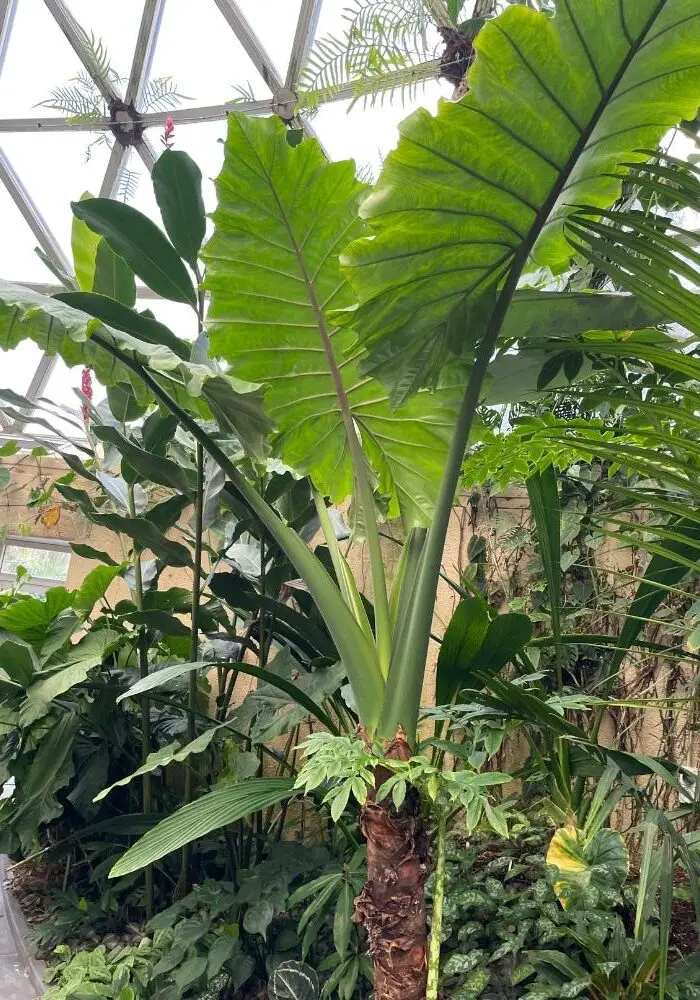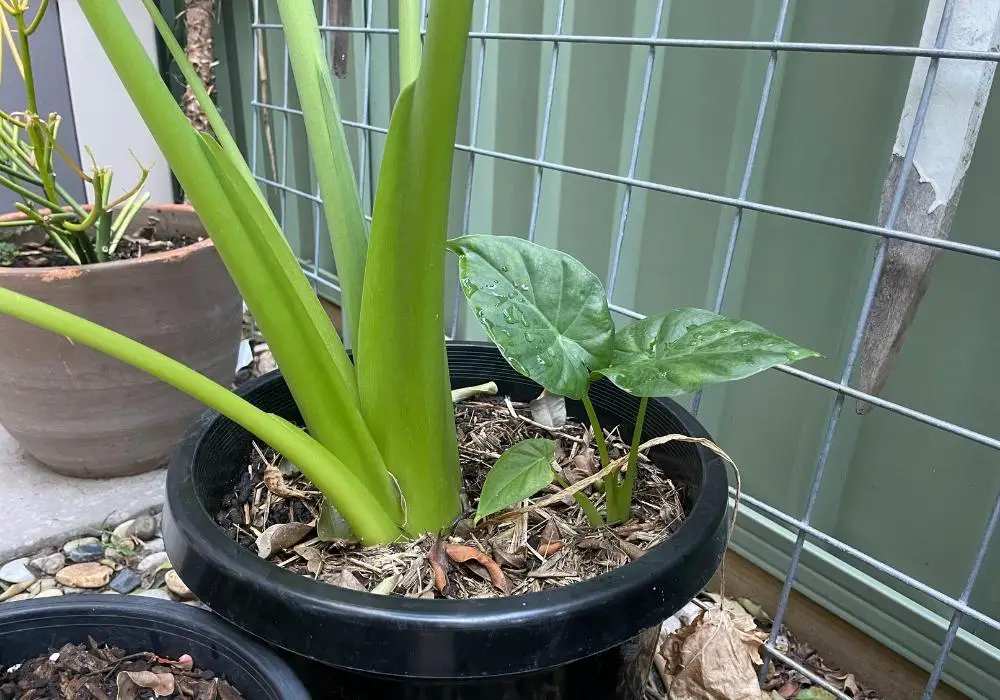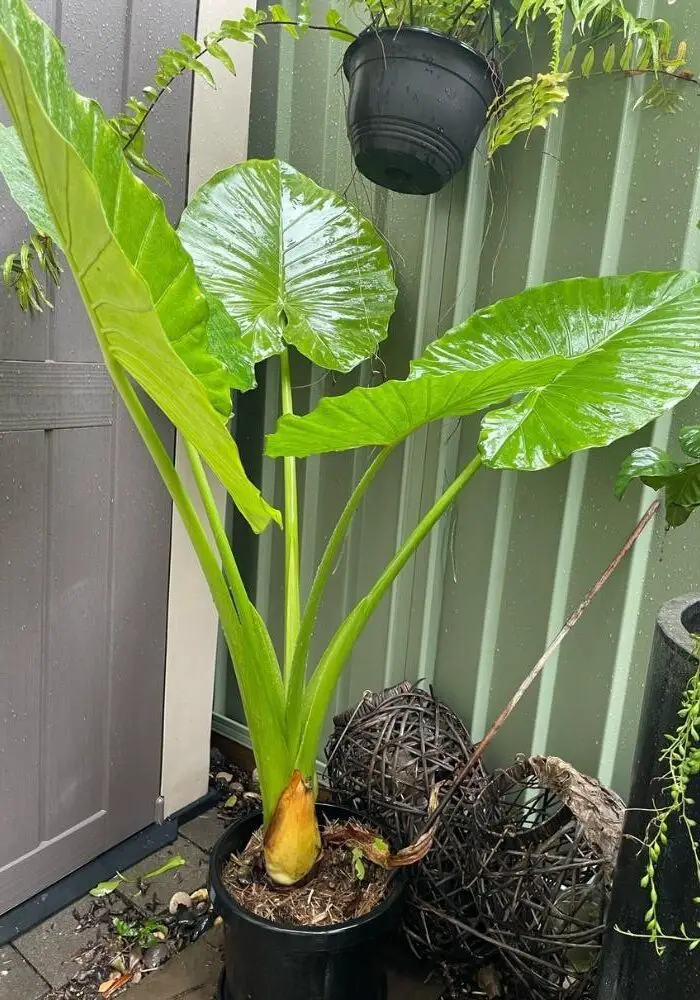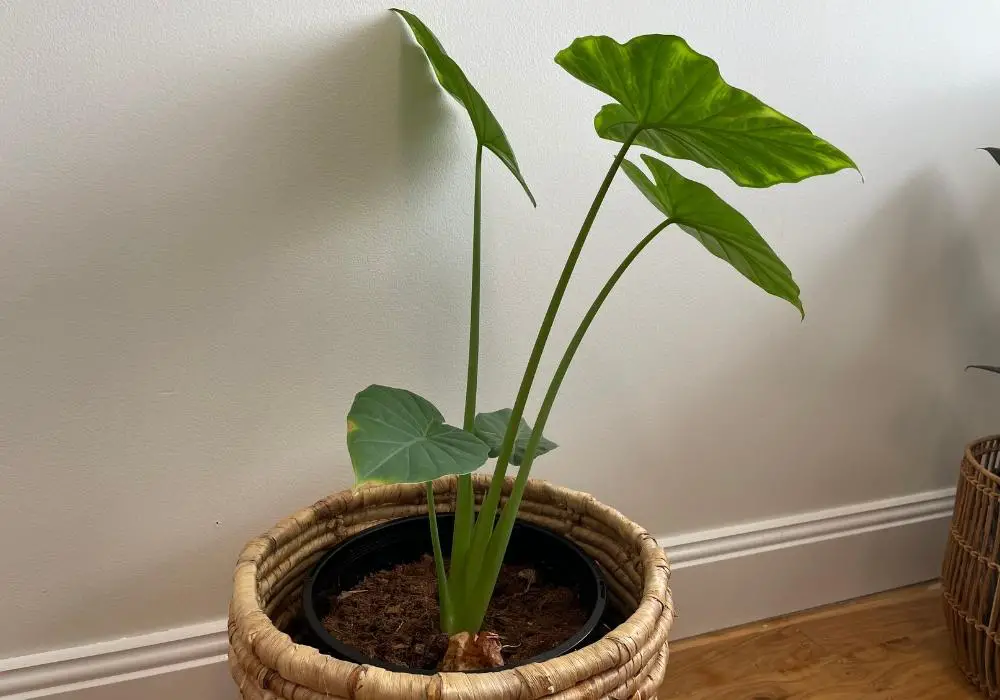Dividing elephant ear plants is an easy way to propagate your plant, and multiply your elephant ear plants. Elephant ear plants spread out and grow by putting out runners from the parent plant. These runners will then come to the surface and start growing as pup/offshoots of the parent plant.
To propagate these plants you need to cut the rhizome of the elephant pup from the parent plant (make sure it has roots attached), then pot the pup into a new pot with a well-draining potting mix. If you are keeping the plants inside you will only need to water them weekly, to begin with, but if they are being kept outside in the full sun you may need to initially water them every 1 to 2 days until established.
Elephant ear propagation is easy to do when new pups grow. Read below and I will explain the exact steps I took to propagate my own elephant ear plant.

I will show you how I propagated my Elocasia species of the elephant ears plant. This large leaf plant is native to Asia (from India to Malaysia and in between), and Australia and can grow happily both indoors and outside provided it gets enough sunlight.
Before Dividing Elephant Ear Plant
Before you divide your elephant ear first you need to ensure your tools are clean and sterilised to prevent the chance of you spreading diseases among your plants.
Also before you cut off a pup from the parent elephant ear plant you need to check that it is mature enough that there are roots attached to it. Having roots already attached to your pup will greatly increase the chance of survival of the pup to almost 100%.

When Is the Right Time to Divide an Elephant Ear Plant?
It is recommended that the pups you remove aren’t planted in an environment with a temperature lower than 7°C (45°F). The growing season of elephant ears is in Spring and Summer, so this would be an ideal time to cut and plant your pups.
These plants grow in warm tropical climates and are found naturally in rainforests, so they are obviously not tolerant of frost. If you live somewhere where there might be some frost, wait for that part of the season to pass before trying to divide your elephant ear plant.
Steps to Divide Elephant Ear Plant
Read on below, and I’ll explain how I divided and propagated my elephant ear plant successfully.

How to Propagate an Elephant Ear Plant (with pups)
-
Identify Elephant Ear Pups Ready to Be Removed

As your elephant ear plant grows, it will start to put out runners to spread and grow more shoots. When one of the runners turns into a pup, and looks like it is ready to be divided from the plant, then you can divide your elephant ear plant.
Before removing the pup from the parent plant, make sure that it has grown roots first. You can do this by removing the soil around it. If it has grown roots there is basically a 100% chance of it successfully growing into another healthy elephant ear plant.
-
Divide the Elephant Ear Pup from The Parent Plant
There are two different ways you can tackle dividing a pup from the parent plant.
(1) If the parent plant is in a pot, you can de-pot and remove all the soil around the pup to clearly see it’s condition and where to cut it.
(2) Leave the parent plant in the ground of the pot and just clear the dirt around the pup, while not disturbing the parent plant, so you can see where to cut it.I prefer the second option because it causes the least amount of disturbance of the parent elephant ear plant.
-
Pot the Elephant Ear Plant Pup

Plant the pup into a pot or into the ground outside.
If planting the pup into a pot, fill up a pot with a well-draining potting mix and plant the pup as deep as it was before you removed it from the ground.
If you are planting the pup outside into the ground, dig a larger hole (roughly 1 foot wide and 1 foot deep, and fill it up with a fresh potting mix. Then plant the pup to the same level as it was before it was divided from the parent plant.
You don’t need to soak the pup in water before being transferred to a pot or the ground.
-
Watering your new elephant ear pup
If you are keeping your elephant ear inside, you will only need to water it 1 to 2 times per week until it is established.
If you are going to plant it outside, you will need to water it every 1 to 2 days until it is established and then you can reduce the watering schedule.
Supply:
- Elephant ear pup
- Plastic grow pot
- Plant potting mix
Tools:
- Sharp and clear utility knife
Final Thoughts
These plants make excellent feature plants and add a tropical feel to your home if displayed either inside or outside.
Follow my steps in the above guide and you will have a high chance of success when multiplying and propagating your elephant ear plants and pups.
FAQs
Can I Split My Elephant Ear Plant?
You cannot split one single elephant ear plant into two. Only when your elephant ear plant starts growing pups can you split the rhizome and divide the pups from the main plant.
When Can You Split an Elephant Ear Plant?
You can split an elephant ear plant any time of the year. The only time I would avoid it is if the weather is colder than 7°C (45°F) and there is the risk of frost.
Can You Separate Elephant Ear Plants in Summer?
Spring to summer is the usual growth period of your elephant ears plant, and if you divide your plant during this time it might disturb its growth. But other than for that reason, you can divide your elephant ear plant in the summer.
Can You Propagate Elephant Ears from Cuttings?
No, you can’t propagate elephant ear plants from cuttings. The only two methods of propagating elephant ear plants are the division method and by germinating seeds.
Can You Grow Elephant Ear Pups in Water?
Yes, elephant ear plants can grow in water.
Elephant ear plants in nature grow in rainforests, alongside bodies of water and areas that are prone to flooding. They are able to grow submerged in ponds and make excellent water feature plants.


